Gujarat Board GSEB Solutions Class 8 Sanskrit Chapter 9 भाषासज्जता Textbook Exercise Important Questions and Answers, Notes Pdf.
Gujarat Board Textbook Solutions Class 8 Sanskrit Chapter 9 भाषासज्जता
GSEB Solutions Class 8 Sanskrit भाषासज्जता Textbook Questions and Answers
1. Write the following words in legible handwriting:
भद्रम्, नृपः, उत्तुङ्गः, भविष्यति, चञ्चलः, शङ्करः
![]()
2. Classify the following sounds according to their production place:
– क, ख, ग, घ्
– प, फ, ब, भ्
– ट्, ठ, ड्, ढ्
Answer:
– क, ख, ग, घ् → Guttural sounds
– प, फ, ब, भ् → Labial sounds
– ट्, ठ, ड्, ढ् → Cerebrate sounds
Sanskrit Digest Std 8 GSEB भाषासज्जता Additional Questions and Answers
1. Answer the following questions :
Question 1.
How many short vowels are there? Which are they ?
Answer:
There are five short vowels : अ, इ, उ, ऋ and ॡ.
Question 2.
What is consonant? How many are they ?
Answer:
The sound (letter) which can be clearly pronounced only with the help of a vowel is known as a consonant. There are 33 consonants.
![]()
Question 3.
What is pronoun ?
Answer:
The word, used in place of noun is called pronoun.
Question 4.
What is root of verb ? How many types of root are there? Which are they?
Answer:
The original form of verb is called root of verb. There are three types of root of verb:
- Parasmaipadi
- Aatmanaipadi
- Ubhayapadi
Question 5.
Write a conjugational sign of first, fourth, sixth and tenth group. (TTUT).
Answer:
Conjugational sign of first group is – अ
Conjugational sign of fourth group is – य
Conjugational sign of sixth group is – अ and
Conjugational sign of tenth group is – अय.
Question 6.
What is group (गण) ?
Answer:
‘गण’ means group, class. Verbs are divided in 1 to 10 parts in Sanskrit language. They are called ‘गण’.
Question 7.
What is a conjugational sign?
Answer:
The root of a verb has a special sign of that group (गण), which is called a sign of ‘गण’. This sign of गण is called conjugational sign. Due to them, the roots of verbs of that ‘गण’ can be known.
Question 8.
How many numbers of verbs are there in Sanskrit ? Which are they?
Answer:
There are three numbers of verbs in Sanskrit :
- Singular
- Dual
- Plural.
2. Choose the correct option for the answer of each of the questions given below :
Question 1.
There are ……………………………………… long vowels.
A. five
B. thirteen
C. thirty-three
D. eight
उत्तर:
D. eight
![]()
Question 2.
क्, ख्, ग्, घ्, ङ् are ……………………………………… sounds.
A. palatal
B. retroflex
C. guttural
D. labial
उत्तर:
C. guttural
Question 3.
प, फ, ब्, भ्, म्, are ……………………………………… sounds.
A. retroflex
B. labial
C. dental
D. palatal
उत्तर:
B. labial
Question 4.
Which is the origin of the sound इ, ई and ऐ?
A. guttural
B. palatal
C. retroflex
D. dental
उत्तर:
B. palatal
![]()
Question 5.
Which are the retroflex sounds ?
A. क्, ख्, ग्, घ्
B. प्, फ्, ब्, भ्
C. त्, य्, द्र, ध्
D. ट्, ठ्, ड्, ढ्
उत्तर:
D. ट्, ठ्, ड्, ढ्
Question 6.
Which is the origin of the sound त्, थ्, द्र, ध्, न्, ल्?
A. guttural
B. labial
C. dental
D. retroflex
उत्तर:
C. dental
Question 7.
How many consonants are there in Sanskrit language ?
A. 10
B. 13
C. 24
D. 33
उत्तर:
D. 33
![]()
Question 8.
write singular form of accusative case from the following forms :
A. रामम्
B. रामौ
C. रामान
D. रामेण
उत्तर:
A. रामम्
Question 9.
Which case does the word ‘बालाः’ show ?
A. Nominative case
B. Accusative case
C. Dative case
D. Genitive case
उत्तर:
A. Nominative case
Question 10.
Which case is Locative ?
A. तृतीया
B. पञ्चमी
C. सप्तमी
D. सम्प्रदान
उत्तर:
C. सप्तमी
Question 11.
गङ्गा ……………………………………… प्रभवति।
A. हिमालयेन
B. हिमालयात्
C. हिमालयस्य
D. हिमालये
उत्तर:
B. हिमालयात्
![]()
Question 12.
……………………………………… प्रसरो महान् अस्ति।
A. वृक्षम्
B. वृक्षाय
C. वृक्षस्य
D. वृक्षात्
उत्तर:
C. वृक्षस्य
Question 13.
आचार्यः प्रत्यवदत्, “अहं कौरवान् पाण्डवान् च ………………………………………।
A. पाठयामः
B. पठामि
C. पाठयति
D. पाठयामि
उत्तर:
C. पाठयति
Question 14.
वर्तमानकाल अन्यपुरुष एकवचनस्य रूपं किम् अस्ति?
A. वदति
B. अवदत्
C. वदसि
D. वदन्ति
उत्तर:
A. वदति
Question 15.
ऋता कुत्र चित्राणि चित्रयति?
A. कलाखण्डम्
B. कलाखण्डेन
C. कलाखण्डाय
D. कलाखण्डे
उत्तर:
D. कलाखण्डे
![]()
Question 16.
Origin of verb is known as …………………………………….. .
A. conjugational sign
B. root
C. person
D. group
उत्तर:
B. root
3. Write the forms of cases of the following words :
- रामस्य – राम
- बालाः – बाला
- वनानि – वन
- यूयम् – युष्मद्
- बालाम् – बाला
- तव – युष्मद्
- गजः – गज
- अस्माकम् – अस्मद्
- वनम् – वन
- देवाः- देव
उत्तर:
- रामस्य – राम Genitive singular of अ-कारान्त masculine.
- बालाः – बाला Nominative, Accusative plural of आ-कारान्त feminine.
- वनानि – वन Nominative, Accusative plural of अ-कारान्त neuter.
- यूयम् – युष्मद् Same Nominative plural in all the three genders of pronoun.
- बालाम् – बाला Accusative plural of आ-कारान्त feminine.
- तव – युष्मद् Same Genitive singular in all the three genders of pronoun.
- गजः – गज Nominative singular of अ-कारान्त masculine.
- अस्माकम् – अस्मद् Same Genitive plural in all the three genders of pronoun.
- वनम् – वन Nominative, Accusative singular of अ-कारान्त Neuter.
- देवाः- देव Nominative plural of अ-कारान्त masculine.
![]()
4. Write the forms of following verbs :
- पठति –
- नमामि –
- नृत्यन्ति –
- लिखामः –
- खादसि –
- गच्छति –
- कथयथः –
- इच्छामि –
- वदन्ति –
- रचयावः –
उत्तर:
- पठति – Present tense of root पठ् (१ प.), Third person singular.
- नमामि – Present tense of root नम् (१ प.), First person singular.
- नृत्यन्ति – Present tense of root नृत् (४ प.), Third person plural.
- लिखामः- Present tense of root लिख (६ प.), First person plural.
- खादसि – Present tense of root खाद् (१ प.), Second person singular.
- गच्छति – Present tense of root गम्-गच्छ (१ प.), Third person singular.
- कथयथः – Parasmaipadi of root कथ् (१० उ.), Present tense, Second person dual.
- इच्छामि – Present tense of root इष्-इच्छ (६ प.), First person singular.
- वदन्ति – Present tense of root वद् (१ प.), Third person plural.
- रचयावः – Parasmaipadi present tense of root रच (१० उ.), First person dual.
5. Choose the locative singular declensions from the following forms and write them down :
शालासु, बालायाः, देवस्य, वने, फलस्य, रामात्, देवे, मालायाः, पुस्तकस्य, गुरौ, आचार्यस्य, वृक्षेण, वृक्षस्य।
Answer:
Forms of Genitive (षष्ठी) singular:
- बालायाः – (बाला, आ-कारान्त feminine Noun.)
- देवस्य – (देव, अ-कारान्त Masculine Noun.)
- फलस्य – (फल, अ-कारान्त Masculine Noun.)
- मालायाः- (माला, आ-कारान्त Feminine Noun.)
- पुस्तकस्य – (पुस्तक, अ-कारान्त Neuter Noun.)
- आचार्यस्य – (आचार्य, अ-कारान्त Masculine Noun.)
- वृक्षस्य – (वृक्ष, अ-कारान्त Masculine Noun.)
![]()
6. Choose and write the present tense (third) person singular forms and write them down :
- लिखामि, लिखसि, लिखति
- नयति, नयन्ति, नयामः
- भ्रमसि, भ्रमति, भ्रमन्ति
- तिष्ठावः, तिष्ठथः, तिष्ठति
उत्तर:
Present tense (third) person singular forms:
- लिखति (लिख, ६ प.)
- नयति (नी-नय्, १ प.)
- भ्रमति (भ्रम्, १ प.)
- तिष्ठति (स्था-तिष्ठ्, १ प.)
भाषासज्जता Good Knowledge of Language
(अ) वर्णपरीचय:
(1) वर्ण: (Sound) – A vowel or a consonant (without a vowel) is known as वर्ण – sound.
(2) स्वर: (Vowels) – The letters (वर्णs) which can be pronounced by themselves are known as vowels or स्वरs.
There are thirteen vowels in Sanskrit : अ, आ, इ, ई, उ, ऊ, ऋ, ऋ, लू, ए, ऐ, ओ, औ।
(3) स्वराणां प्रकारा: (Types of vowels) –
- हस्तस्वर: (Short vowels),
- दीर्धस्वर: (Long vowels) and
- संयुक्तस्वर: (Dipthongs)
1. व्यज्जन: (Short vowels) – These are five in all : अ, इ, उ, ऋ, and लृ (लृ is not used any more. You may find it in old Vedic Sanskrit literature.)
2. दीर्धस्वर: (Long vowels) – These are eight in all : आ, ई, ऊ, ऋ, ए, ऐ, ओ, and औ।
3. संयुक्यस्वरs: (Dipthongs) – The last four vowels in the list of long vowels (ए, ऐ, ओ, and औ) are called dipthongs (संधिस्वर) as they are formed with two vowels. e.g., ए = अ or आ + इ or ई; ऐ = अ/आ + ए; ओ = अ or आ + उ or ऊ; औ = अ or आ + ओ।
(4) व्यज्जनs (Consonants) – The sound (letter) which can be clearly pronounced only with the help of a vowel is, known as a Consonant. There are thirty-three in all : From क् to ह।
(5) व्यज्जनानां प्रकारा: (Types of consonants) – The following table will give a clear idea of all the vowels and consonants :
![]()
Origins of Consonant Sounds

(6) स्पर्शव्यञ्जनानि (वर्गीयव्यञ्जनानि वा) (Plosives) – Twenty-five consonants from क् to म् are known as ‘स्पर्श व्यंजनs’. They are also known as – ‘वर्गीय व्यंजनs’.
(7) Fejchilardifor (Conjunct or compounded consonants) – When two or more consonants are written without a vowel in between, they become conjunct or compounded consonants; In such consonants a vowel is added only to the last consonant for e.g., क् + ष् + अ = क्ष; ज् + ञ् + अ = ज्ञ; क् + त् + अ = क्त or क्त; श् + र् + ई = श्री; प् + र् + अ = प्र; त् + र् + आ = त्रा, etc.
(8) विसर्ग: (Visarga) – In words like राम: देव:, etc., the sign like a colon (:) is written. This sign ( : ) is called ‘visarga’. It is difficult to explain the correct pronunciation of visarga, but the style (manner) of pronouncing it can be roughly made clear by the following table :
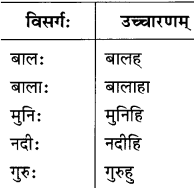
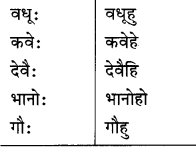
![]()
(9) देवनागरी नगरी लिपि: (Devnagari script (or Nagari script)] – All the letters – vowels and consonants shown above are written in a script known as the ‘Devnagari’ or ‘Nagari script. Our National language, Hindi is also written in the same script.
Activities
| Answer the following questions on the basis of the table : (1) Write the letters of guttaral sound and divide them into vowels and consonants. (2) Write the letters of palatal sound and divide them into vowels and consonants. (3) Write the letters of cerebral sound and divide them into vowels and consonants. |
विभक्तिपरिचयः
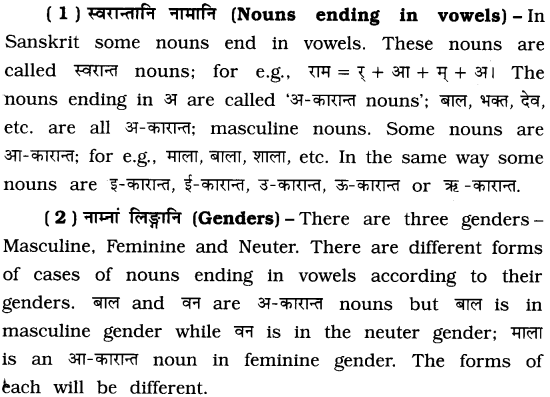
(3) विभक्ति: (Case) – In a sentence the noun is related to the verb in different ways. The nominal cases establish (show) these relationships. These nouns are connected with the verbs in six different relations by means of six cases. The sixth (Genitive) case is such that it establishes the relation of one noun with another in the sentence. This is the Genitive case – in simple words – the case showing possession. The eighth (vocative) case is used either to call or address’ another noun. It is just another form of the nominative (first) case.
(4) विभक्तीनां नामानि कार्याणि च (Name and use of each case) – The names and functions of cases will be clear from the following table :
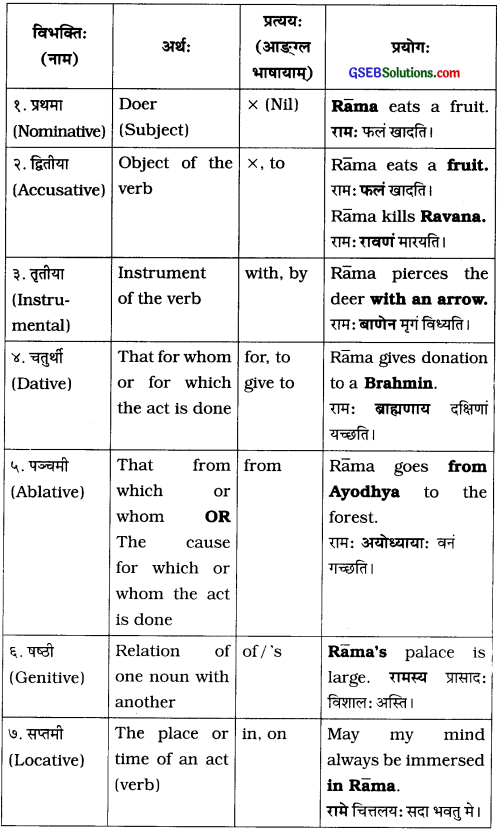

![]()

Let us now look at the declensions of some अ-कारान्त masculine nouns :
केषाञ्चित् अ-कारान्त पुंल्लिङ्गशब्दानां रूपाख्यानानि
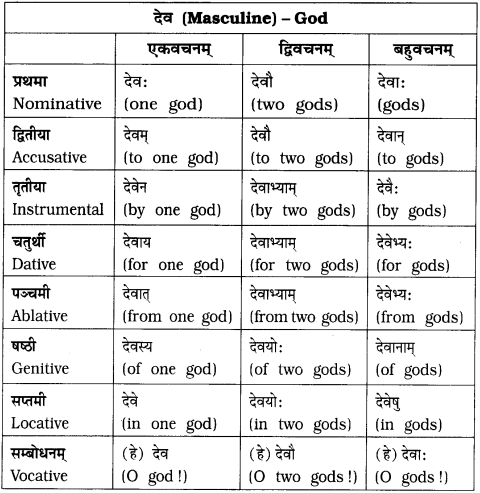
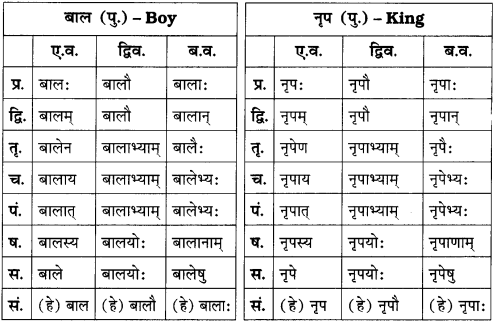
(Note: In the word (noun) नृप the Instrumental singular and Genitive plural declenslons take ण् In place of न् i.e., changes to न् in these forms.)
![]()
Activity
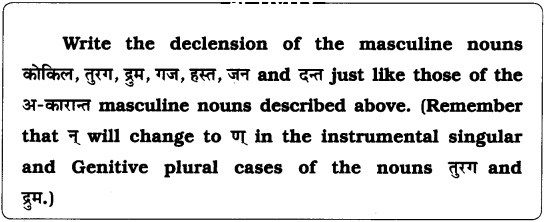
केषाञ्चित् अ-कारान्त-नपुंसकलिङ्गशब्दानां रूपाख्यानानि

Note : The declensions of the nominative, accusative and vocative (first, second and eighth) cases of all the neuter gender अ-कारान्त nouns are different from those of masculine अ-कारान्त nouns; the declensions from the (instrumental to locative) third to the seventh case are the same.
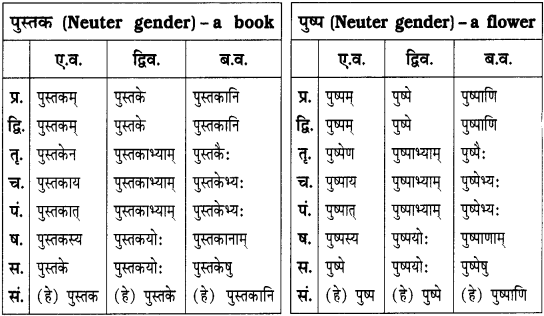
Note : In the first, second and eighth case, the plural declensions as well as the third singular and the sixth plural declensions of the noun ‘पुष्प’, नृ has changed to ण.
![]()
आ-कारान्त-स्त्रीलिङ्गशब्दानां रूपाख्यानानि
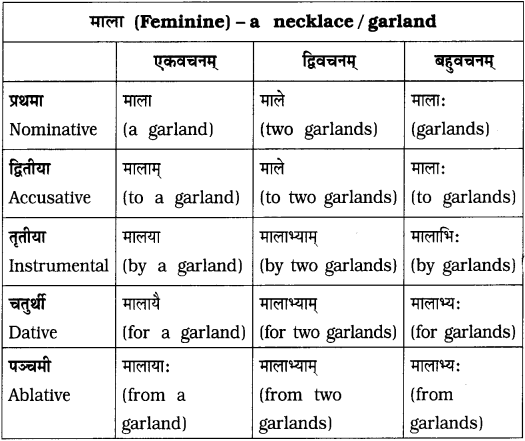
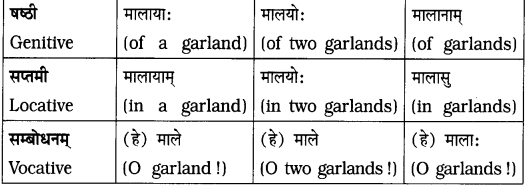
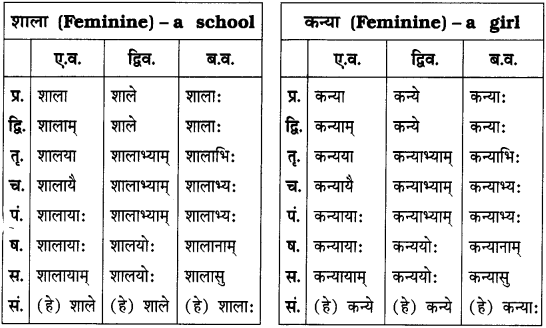
Activity

![]()
स्मृतिस्थं कुरुत (Remember)

सर्वनामानि
The word which is used instead of a noun is called a ‘pronoun’.
अस्मद् (I, we) and युष्मद् (you) have the same forms in all the three genders. These two pronouns are used very often in a language. The declensions of the nominative, accusative and Genitive cases are given here :
अस्मद् (Pronoun) – I, we
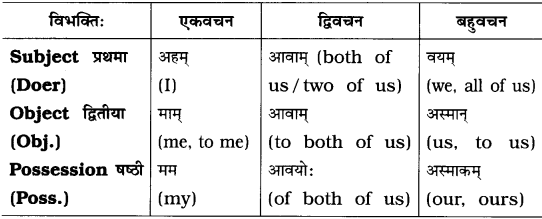
युष्मद् (Pronoun) – you, you all
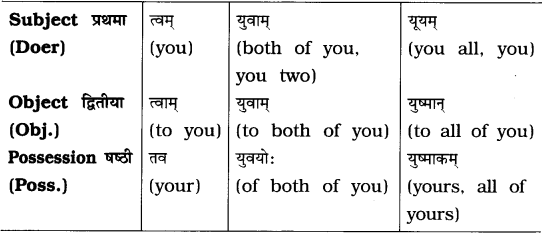
Read the following sentences and study the underlined words :
- अहम् जानामि। तव गृहं सुन्दरम् अस्ति।
- माला मम सखी अस्ति। अहं त्वां पश्यामि।
- हे सीते, त्वमृ मया सह मा आगच्छ।
The underlined words are pronouns.
Activity
| Find such pronouns from the lesson and understand their use(s) |
![]()
To understand the use of various cases read the following verses carefully :
रामो राजमणिः सदा विजयते रामं रमेशं भजे।
रामेणाभिहता निशाचरचमूः रामाय तस्मै नमः।
रामान्नास्ति परायणं परतरं रामस्य दासोऽस्म्यहम्।
रामे चित्तलयः सदा भवतु मे भो राम मामुद्धर।।
Here राम: is in nominative case (doer / subject),
रामम् (to R\(\bar{a}\)ma) is in the accusative case,
रामेण (by R\(\bar{a}\)ma) is in the instrumental case,
रामाय (for R\(\bar{a}\)ma) is in the dative case (नमः always takes the fourth case),
रामात् (from R\(\bar{a}\)ma) is in the ablative case,
रामस्य (of R\(\bar{a}\)ma) is in the Genitive case,
रामे (in, on R\(\bar{a}\)ma) is in the locative case and
भो राम (O R\(\bar{a}\)ma) is in the vocative case.
Thus, by reading the above verse carefully, we become familiar with all the declensions of राम as these have been used in the verse.
Now study the following verses :
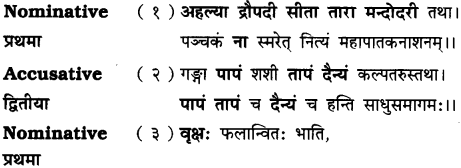
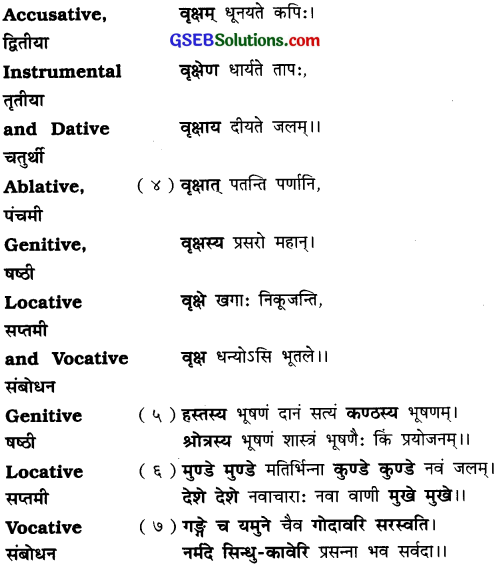
![]()
One cannot master the cases and their declesions by learning them by heart. They can be easily remembered by using them daily. We can understand declensions through the medium of verses, by reading and speaking the language.
क्रियापदानां परिचयः
प्रथम-चतुर्थ-षष्ठ-दशमगणाः
(1) धातुः (A root) – The basic form of a verb is known as धातु (root) in Sanskrit; e.g., नम्, तुष्, विश्, गण।
(2) क्रियापदम् (A verb) – By adding certain suffixes (प्रत्यय’s) to roots, a verb is formed.
(3) गण: (A conjugation) – गण means a group. All Sanskrit roots have been divided into 10 groups. Thus there are 10 conjugations of roots. They are known as the 1st conjugation, 2nd conjugation, etc.
(4) विकरणप्रत्यय: (A conjugational sign) – The top of the root can be recognised from the mark such as अ, य, etc. This is known as the ‘विकरणप्रत्यय’. We have to study the four groups – 1, 4, 6 and 10 here. Their विकरणप्रत्ययs are as follows:
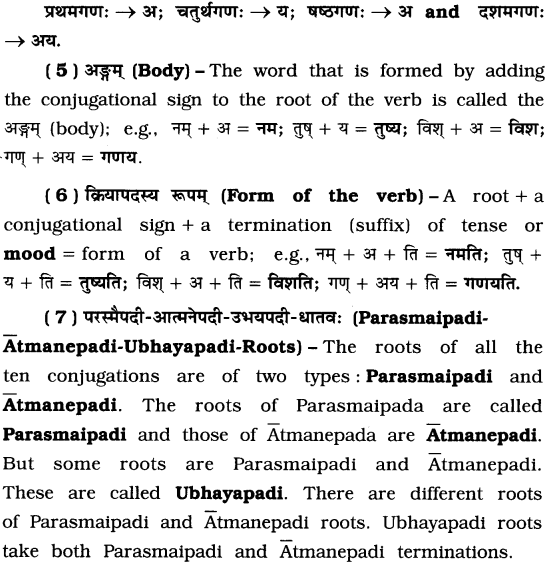
(8) परस्मैपदीधातूनां कृते वर्तमानकाल(लट् लकार)स्य प्रत्ययाः –
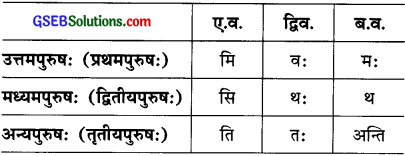
(9) क्रियापदानां वचनानि (Numbers of verbs) – There are three numbers for every verb – singular (for one object or person); dual (for two objects or persons) and plural (for three or more objects or persons)
![]()
(10) प्रथम-चतुर्थ-षष्ठ-दशमगणानां केषाञ्चित् धातूनां वर्तमानकालस्य रूपाणि- नम् – to bow down (First conj. parasmaipada root)
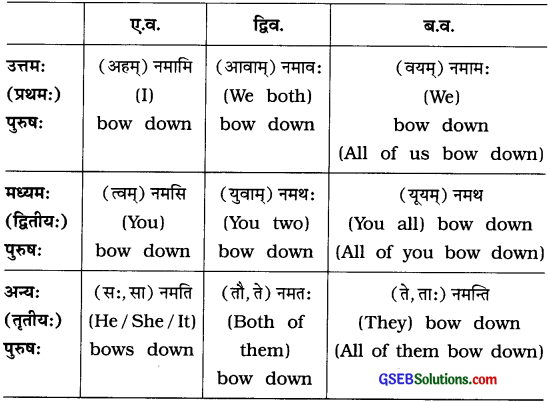
१. वद् (वदति)to
speak (१ प.)
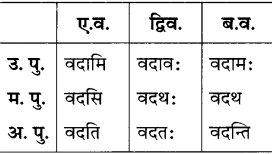
२. पा (पिब्-पिबति)
to drink (१ प.)
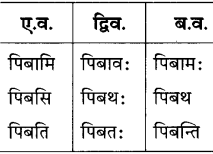
३. गम् (गच्छ-गच्छति)
to go (१ प.)
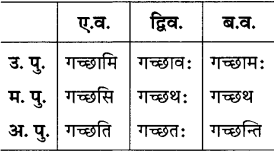
४. भू (भव-भवति)
to be (१ प.)
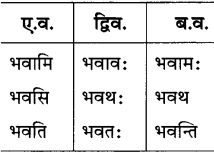
![]()
Singular

Note : Make sentences by using the pronouns given above by combining them with nouns and verbs :
Example :
एषः युवकः पठति।
Use verbs like लिखति, गच्छति, नमति, etc., in place of ‘पठति’ and form, say and note down more sentences in Sanskrit.
Dual
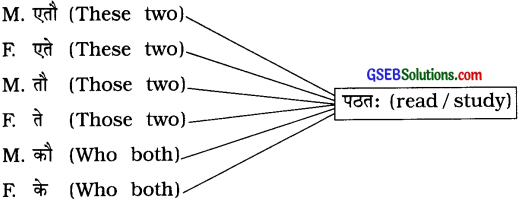
Plural
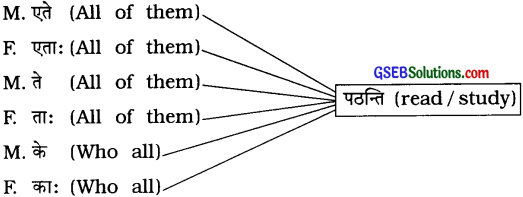
Activity
| In your notebook write the present tense (लट् लकार) forms of the first conjugation, parasmaipada roots – पठ्, वह, दा (यच्छ), जि (जय), ह (हर), रुह (रोह), वृष् (वर्ष), नी (नय) and स्मृ (स्मर). |
चतुर्थगणः परस्मैपद्याम् तुष् (तुष्यति) – to be satisfied
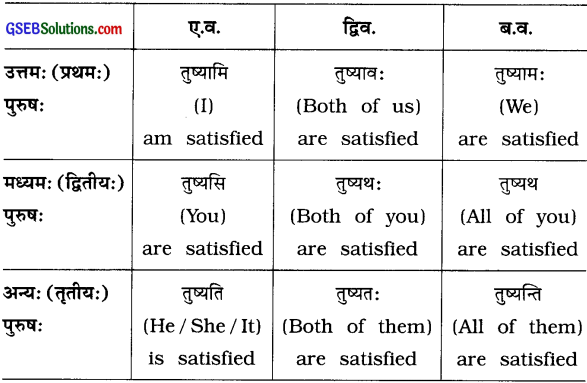
![]()
1. कुप् (४ प.) (कुप्यति)
to be angry
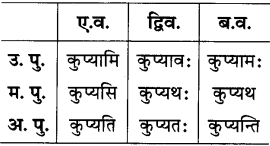
2. श्रम् (४ प.) (श्राम्यति)
to work hard

Activity
| In your notebook write the present tense (लट् लकार) forms of the fourth conjugation, parasmaipada roots – नृत्, नश्, सिध्, क्रुध्, कम् (काम्), स्निह् , भ्रम् (भ्राम्) and क्लम् (क्लाम्). |
प्रच्छ- पृच्छ (पृच्छति – To ask)
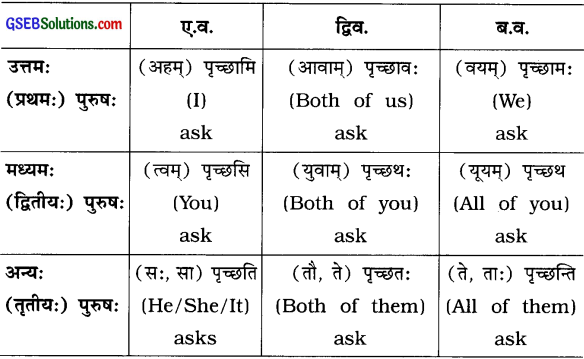
1. विद् – विन्द (६ उ.)
Parasmaipadi – to get
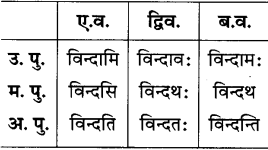
2. इष (इच्छ – इच्छति)
to wish (६ प.)
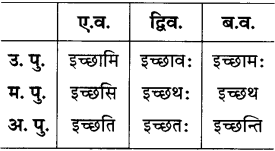
![]()
Activity
| In your notebook write the present tense (लट् लकार) forms of the sixth conjugation, parasmaipada roots – सृज, गुम्फ, स्फुट्, विश्, सिच् (सिञ्च), मुच् (मुञ्च) and कृत् (कृन्त्). |
रच् (रचयति)-(१० उ.) Parasmaipadi root-Compose

1. पूज् – पूजयति
to worship (१० उ.) परस्मैपदी
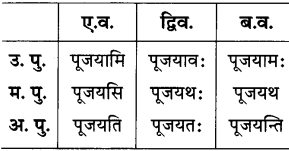
2. घुष् (घोष्-घोषयति)
to announce (१० प.)
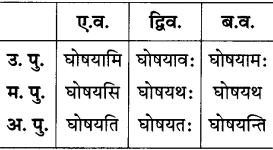
Activity
| In your notebook write the present tense (लट् लकार) forms of the tenth conjugation, parasmaipada roots – कथ्, चिन्त्, रच्, चुर् (चोर), तुल् (तोल्), तड़ (ताड्), प्री (प्रीण) and धृ (धार). |
(इ) अस् (२ प.) – कृ (८ प.) इत्यनयोः धात्वोः
वर्तमानकाल(लट् लकार)स्य रूपाणि
अस् (२ प.) – to be and कृ (८ प.) – to do. The forms of these roots are used often while using a language. So it is necessary to know (learn) their forms.
![]()
अस् (२ प.)-to be

कृ (८ प.)-to do
